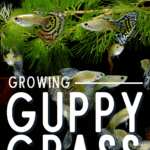Would you like to grow plants in your freshwater aquarium, but hold back because you’re worried that you don’t have the right equipment? Then you’ll likely love the fast-growing aquatic plant known as Guppy Grass! These aquarium grasses are easy to grow and don’t require any special equipment to thrive in your tank.
Introduction To The Low-Maintenance Guppy Grass
One downside to having a planted freshwater tank are the expensive lights and special fertilizers needed to keep many aquatic plants from turning brown and dying in your aquarium. If you’re looking for one of the easiest low-maintenance aquatic plants then consider growing Common Water Nymph aka Guppy or Najas Grass!
What Is Guppy Or Najas Grass?
Guppy grass (Najas guadalupensis) is a fast-growing annual aquatic plant commonly found in streams, ditches, and ponds throughout the New World. It’s grown as a floating, weighted or rooted aquarium plant and is ideal for shrimp and fry tanks. It also removes toxins and helps oxygenate the water.
While these plants are native to North, Central and South America, guppy grasses have been introduced to waterways around the world and may be considered an invasive species in some locations due to their uncontrollable spread.
Appearance And Growth Habits
Najas grasses are a popular choice with aquarists of all experience levels due to their fine-leaved texture and rapid, uncomplicated growth and propagation:
- Najas grasses have thin, nearly transparent green leaves about 3 centimeters long and 1 to 2 centimeters wide, which grow on the opposite sides of the stem in a whorled pattern and are edged with tiny unicellular teeth.
- They have multiple slender, branching stems which are very flexible and can reach up to 3-feet in length if not trimmed back.
- These grasses can be grown as a floating plant, but may also be rooted in your substrate or held in place using plant weights.
- They are easily propagated from stem cuttings and don’t require intense lighting conditions or CO2 injection to thrive, although using a basic liquid fertilizer may be helpful in some situations.
Care Tips: How To Use Najas Grass In Your Aquarium
Najas is an ideal option for any planted or aquascaped habitat, but is especially favored for breeding set-ups and shrimp tanks. It was originally a favorite of guppy breeders, hence the nickname “guppy grass,” but it’s rapid growth, easy propagation and fine texture also makes it a desirable background plant for community tanks.
The uses of Najas include:
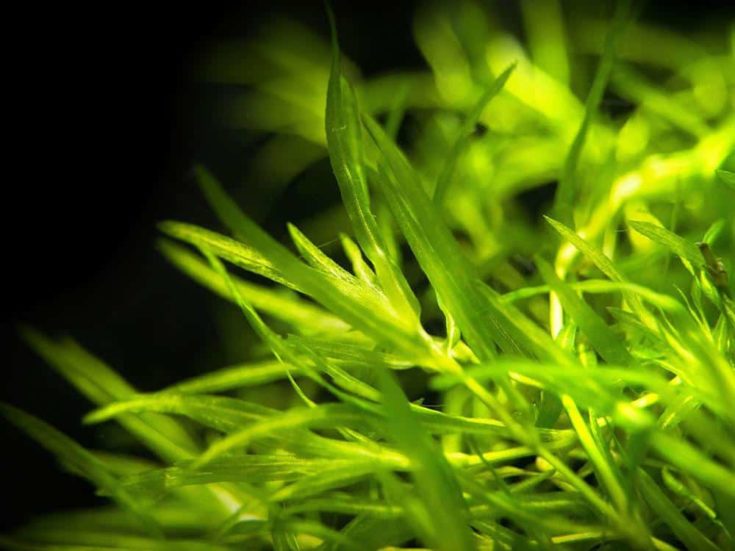
- Plant or float a cluster to provide a thick growth of fine leaves and stems that protects and shelters delicate fry and invertebrates, and helps trap microscopic particles of food to feed them.
- Grow these plants as a fresh snack for your vegetarian and omnivorous fish like goldfish, some freshwater sharks, and algae-eating fish.
- These grasses rapidly absorb the excess nutrients in your tank’s water column and help keep your water clean and prevent nasty algae outbreaks.
- Najas grasses specifically remove toxins like ammonia, nitrate and nitrite, but they also absorb heavy metals and just about every other nutrient in the water!
- They’re often used in heavily stocked tanks to reduce the load on the filters, in addition to their algae-fighting properties.
- Fast-growing aquatic plants like guppy grasses also produce a lot of oxygen and help prevent the development of Dead Zones in your tank.
- You can use Najas grasses as a background plant lightly rooted in the substrate or held down with plant weights, or keep bundles floating in your water column.
Benefits of Growing Najas Grass
Provides shelter for small fish, shrimp and fry
Filters out toxins and waste products
Absorbs nutrients to prevent algae outbreaks
Produces oxygen and prevents Dead Zones
Is a fast-growing floating, rooted, or weighted plant
Downsides to Using Najas
Regular water changes needed for healthy growth and propagation
May need to use a weekly liquid fertilizer
Frequent pruning and removal is usually required to control growth
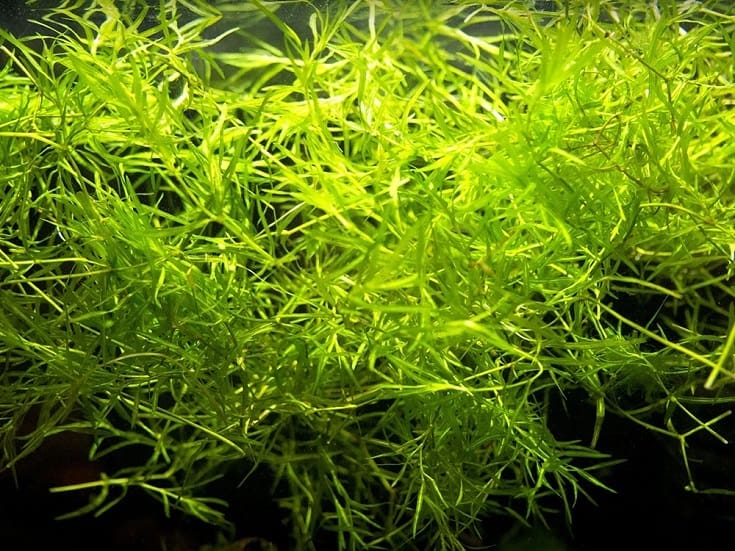
How To Care For Guppy Grass
Guppy grass is not a picky plant and usually thrives in most aquariums without much effort. Truthfully, it’s usually harder to control its growth and spread than it is to encourage it! Let’s take a look at some tips for growing this plant in your aquarium:
Tank Set-up, Water Parameters And Lighting Requirements
Guppy grass can be kept in aquariums of all sizes, but its rapid growth habits mean it can quickly overwhelm smaller Nano Tanks if not pruned back frequently. It can also cause problems by clogging your filter intakes, and does best in tanks with a minimal current and flow rate. These grasses:
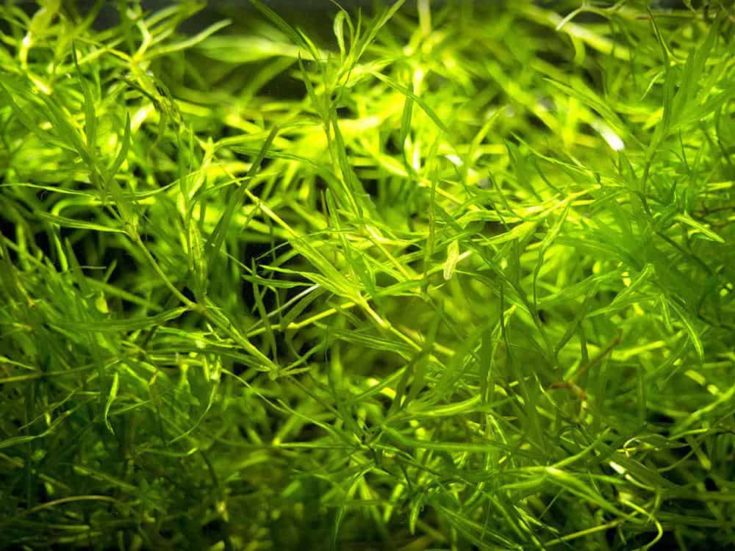
- Thrive on 8 to 12 hours a day of low to moderate lighting conditions, so you may not even need a supplemental light fixture for your set-up if your tank is in a bright location.
- Prefer water temperatures from 68 to 79°F and do well over a wide pH range from 6.0 to 8.0.
- Are not especially sensitive to your water hardness and tolerate from 2 to 20 degrees of general hardness (dGH).
Fertilization, Substrate And Maintenance
Guppy grasses draw nutrition directly out of your water column, so you don’t need to use an enriched plant substrate or fertilizer tabs and can grow in any type of soil, sand or gravel. You can even opt for a bare-bottomed tank and just float your grass in the water if you prefer. Guppy grasses are very easy to maintain:
- Like all aquatic plants, regular water changes are key if you want a thriving garden of grass and also helps to replace the essential trace minerals and nutrients they absorb from your tank’s water.
- These grasses utilize the ammonia and other organic waste in your tank for food and help keep your water clean and well-oxygenated.
- If your grass isn’t growing very quickly or looks a bit yellow from a lack of carbon, you can use a balanced liquid fertilizer once a week to give it a boost, but you don’t need to invest in CO2 diffusers or injection systems.
Common Problems
Najas grasses present one common problem for aquarists: They grow so quickly they can rapidly take over your entire aquarium! If you don’t regularly and frequently prune the vegetation and remove the excess growth from your tank, they’ll spread out and block all the light from reaching your other plants and animals.
These plants sometimes suffer from a condition called “najas grass melt” when their growing conditions change suddenly. Just after planting stems in your substrate, the leaves may look droopy and almost as if they are melting. It can take a few weeks for the grasses to recover and produce fresh, normal-looking leaves.
Life Cycle And Propagation
Guppy grasses are an annual aquatic plant that spreads through cuttings. Their brittle stems are easily broken, and a fractured stem will quickly form small white roots as it floats in the water. While these grasses do produce small and inconspicuous staminate and pistillate flowers, they don’t form seeds or fruit in an aquarium.
To propagate your guppy grasses, all you have to do is break off a few inches from an actively growing stem! You can grow these grasses as a floating or weighted cluster, or you can plant the stems loosely in your substrate and allow them to root into it. To plant your grasses in substrate:
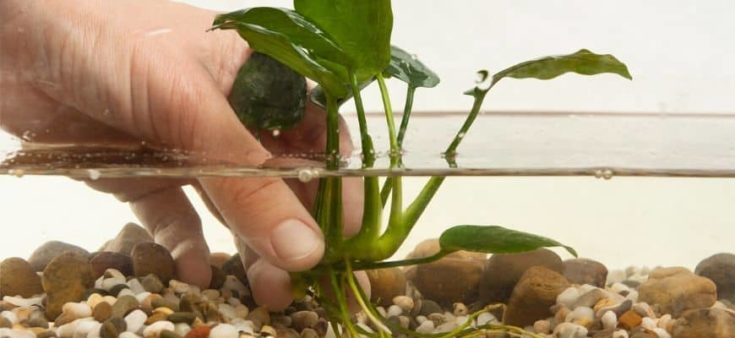
- Collect or purchase a bundle of fresh stem cuttings about 4 to 6 inches long.
- Using your finger or planting tools, gently poke the bottom of each stem about 1-inch into your substrate, or deep enough to prevent the stem from floating away.
- You can plant the stems close together to form a dense mat of growth or spread them further apart a looser grassy-forest appearance.
- Don’t plant the stems deeply, since the roots will develop near the surface.
- Occasionally replant fresh stem segments to replenish your grasses.
Compatibility
Najas grasses are a popular option for a wide range of planted community aquariums and are suitable for nearly all freshwater set-ups. Whether you’re keeping semi-aggressive barbs or cichlids or have a peaceful Rainbowfish or Gourami tank, the purification powers of these grasses will benefit your community.
Breeders of live-bearing fish like Guppies, Mollies, Platys and Swordtails utilize clusters of guppy grass for raising and sheltering their fry. But they also provide protection and food for communities with:
- Small nano fish like Tetras, Rasboras and Minnows.
- Freshwater invertebrates like Cherry, Ghost and Glass shrimp and Nerite, Malaysian Trumpet, Mystery and Assassin snails.
- Omnivorous catfish like the Otocincluis, Siamese Algae Eater and Bristlenose Plecostomus.
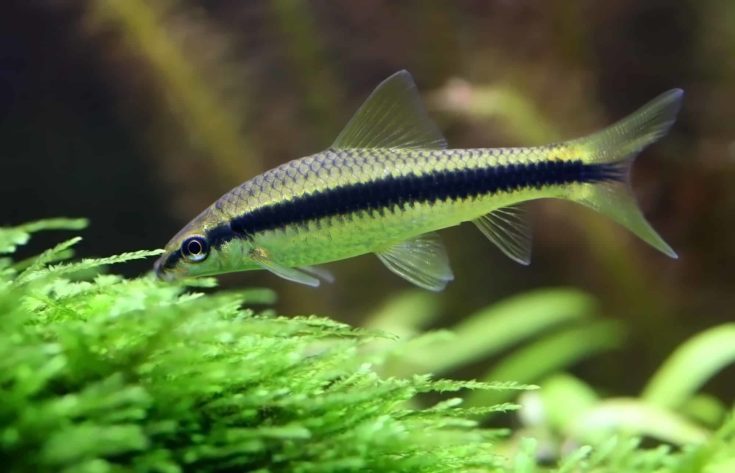
Common Names
Guppy Grass, Common Water Nymph, Najas Grass
Scientific Name
Najas guadalupensis
Growth Rate
Fast
Difficulty
Easy
Maximum Size
up to 3 feet if not trimmed back
Temperature Range
68 to 79°F
pH Range
6.0 to 8.0
Water Hardness (GH)
2 to 20 dGH
Light Requirements
Low to Moderate
Compatibility
Ideal for breeding, shrimp and community tanks, and especially for sheltering small animals and fry. Also a good choice for highly stocked tanks since they remove toxins from the water
Ideal Tank Placement
Floating, planted in substrate or secured with plant weights
Propagation
Cuttings from vertical growth and side stems
Conclusion
Even if you’re not raising guppies, having guppy or najas grasses in your aquarium offers a lot of benefits. These fast-growing low-maintenance plants remove toxins from your tank and provide shelter and food to small fish, shrimp and fry. We’d love to hear about your experiences with these plants, so drop a comment below or come join our community on social media!
